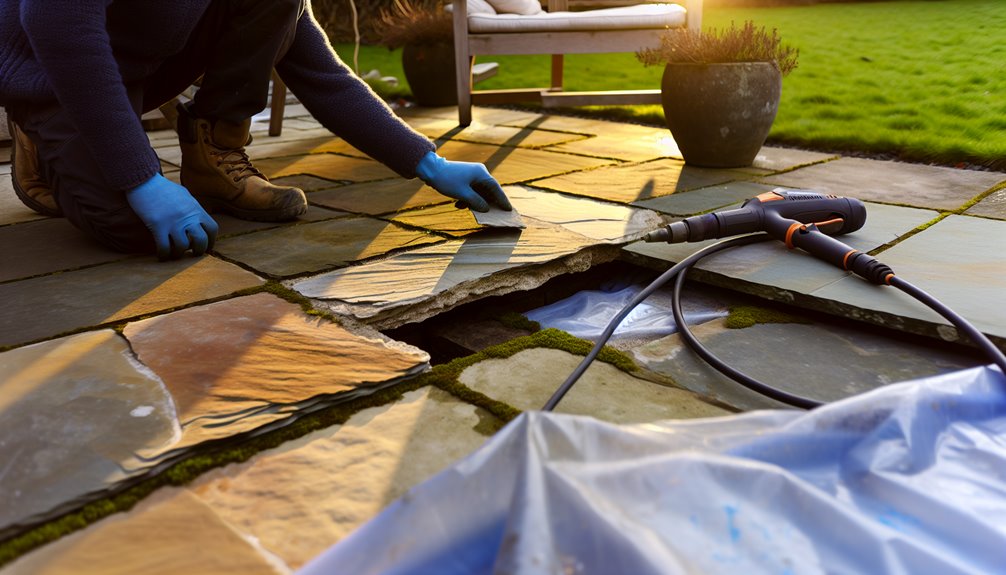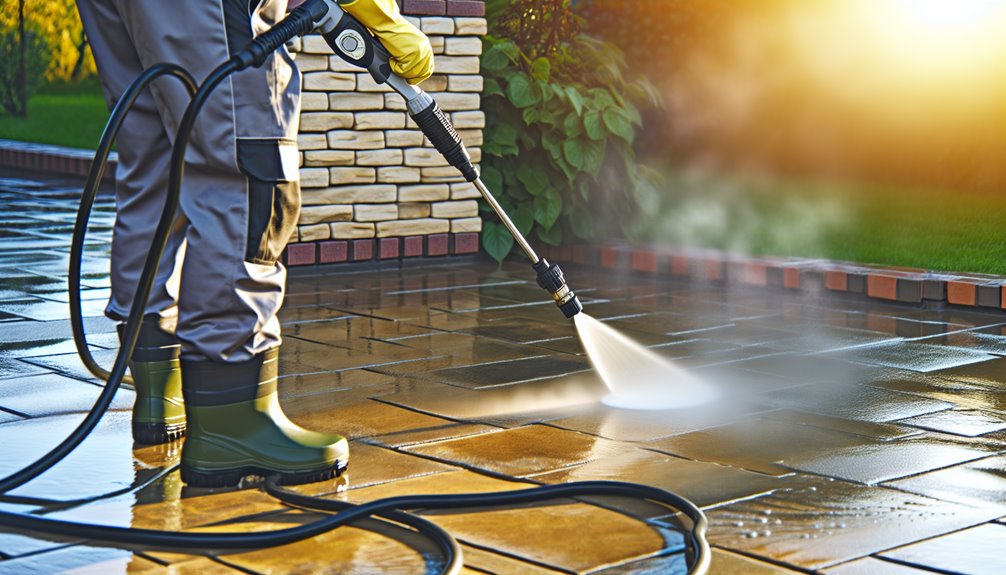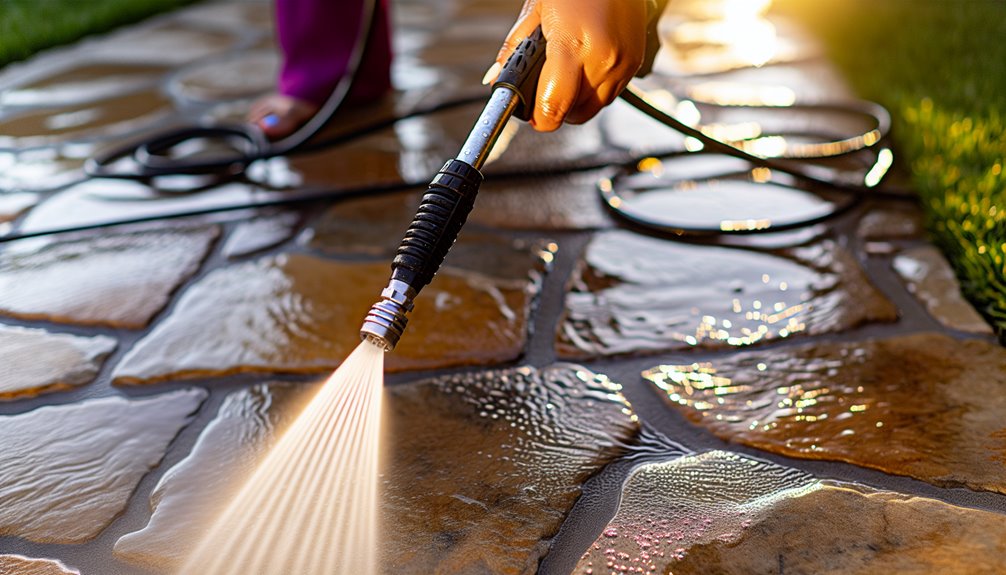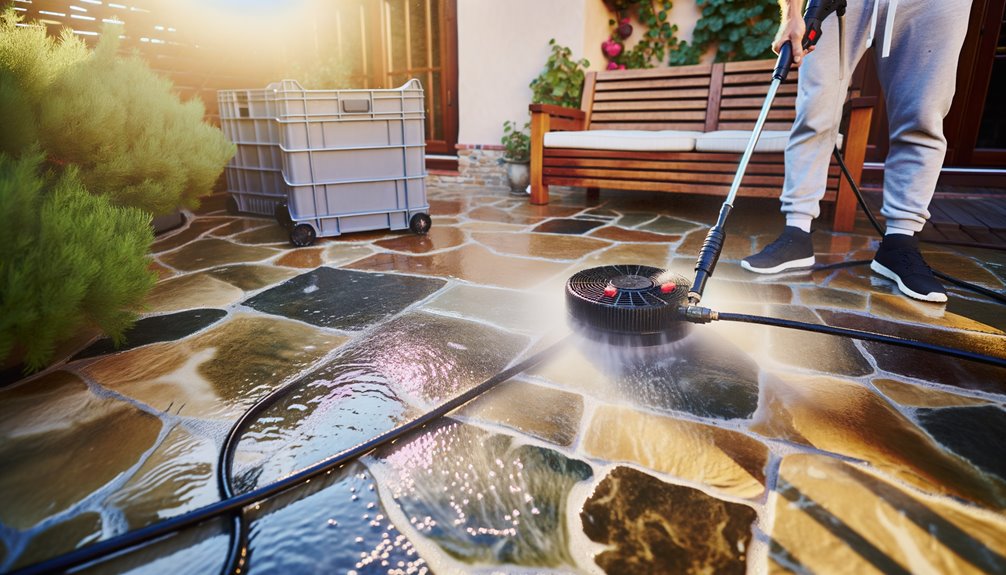Up to 60% of patio damage from washing comes from using the wrong pressure or nozzle. You’ll avoid that by identifying your surface—concrete, pavers, brick, or stone—checking for cracks or loose joints, then starting with a wide 25–40° tip at low PSI. Hold the wand 12–18 inches away at a 30–45° angle, overlap passes, and pre-treat stains. Protect plants, control runoff, and verify drainage. Next, you’ll match safe PSI and GPM by material—and why it matters.
Assess Your Patio Material and Condition

Before you turn on the washer, identify what your patio is made of—concrete, brick, pavers, natural stone, composite, or wood—and note its condition. Mark cracks, spalling, loose joints, failing grout, raised nails, or soft spots. Document drainage slope. Perform basic material testing: scrape inconspicuous areas to gauge hardness, sealant presence, or friability. Use moisture mapping after rainfall or rinsing to locate saturated zones, efflorescence, algae, or mildew reservoirs. Flag edges, expansion joints, and painted or stained sections as high-risk. Protect nearby landscaping and outlets. Remove furniture, sweep debris, and pre-treat stains. Plan gentle passes around fragile areas to prevent damage.
Choose the Right Pressure Washer and Nozzles
Two factors drive your choice: machine power (PSI/GPM) and nozzle angle/orifice. Match an electric or gas washer to your patio’s size and access needs; prioritize consistent flow, reliable pumps, and ergonomic wands to reduce fatigue while serving others efficiently. Select quick-connect nozzles: 40° for rinsing, 25° for general cleaning, 15° for stubborn grime. Avoid pin-point tips on patios. Choose stainless or ceramic tips to extend nozzle lifespan and maintain spray accuracy. Use machines compatible with upstream or downstream chemical injection for synthetic detergents. Pair detergent-rated hoses and filters. Confirm thermal relief valves, GFCI protection, and clear labeling for safe operation.
Set Safe PSI and GPM for Concrete, Brick, and Stone

Although higher pressure seems faster, you’ll protect surfaces and equipment by matching PSI and GPM to the material and soil load. Concrete tolerates more force than brick or soft stone, but flow still does the cleaning. Set pressure conservatively, confirm results, then adjust.
- Concrete: start near 2,500–3,000 psi with 2.5 gpm; raise only if dwell and distance don’t clear soil.
- Brick: limit to about 1,500–2,000 psi; aim for 2.5–4.0 gpm for rinsing without gouging joints.
- Natural stone: begin at 1,200 psi; increase slowly while protecting edges.
- Pavers: use 1,200–2,000 psi with 4.0 gpm to lift grime while preserving sand.
Pre-Clean: Sweep, Degrease, and Pre-Treat Stains
Starting clean reduces pressure, chemical use, and risk. Begin with a dry broom sweep to remove grit that can scratch surfaces and clog nozzles. Vacuum joints if sand or debris accumulates. Identify contaminants: oil, algae, rust, tannins. Apply a degreaser for petroleum stains; choose an enzymatic cleaner for food and organic residue. Pre-wet adjacent plants, then mask metal fixtures. Work in shade; heat flashes chemicals dry. Agitate with a nylon brush, not wire. Dwell times matter—follow labels precisely, then rinse low-pressure. Spot-treat rust with oxalic-based remover; avoid acid on limestone. Allow surfaces to rest, then assess for remaining spots.
Washing Technique: Distance, Angle, and Overlap Patterns

With stains pre-treated and rinsed, set your washer for controlled removal, not surface damage. Hold the wand 12–18 inches from the patio and maintain a 30–45° angle. Lock your stance, brace elbows, and lead with steady spray rhythm. Think nozzle choreography: deliberate passes, zero hesitation, no gouging.
- Start at the far edge, work toward drains, overlapping each pass by one-third.
- Keep the tip moving before squeezing the trigger; never dwell on joints or edges.
- Use a 25°–40° fan tip; test on an inconspicuous spot first.
- Adjust distance for material: increase gap on soft stone, decrease slightly on dense concrete.
Rinsing, Spot Treatment, and Post-Wash Inspection
Once the main passes are complete, switch to a wide fan tip and thoroughly rinse from the highest point toward drains, pushing slurry and loosened grit off the surface. Maintain a controlled rinse sequence, overlapping lanes to prevent redeposit. Keep footwear slip-resistant and protect nearby landscaping with low-pressure edges.
Address remaining spots with stain targeting: apply appropriate cleaner (rust, tannin, oil) per manufacturer dwell times, then lightly agitate with a soft brush. Rinse locally with a gentle fan.
Conduct a post-wash inspection: verify uniform color, check joints for dislodged sand, note chips, and confirm drainage paths are clear. Document findings for client transparency.
Sealing, Drying Times, and Ongoing Maintenance Tips

Before you consider sealing, confirm the patio is fully dry and the forecast stays above the product’s minimum temperature with no rain or heavy dew for 24–48 hours. Test dryness by taping plastic overnight; condensation means wait. Choose compatible seal coatings—penetrating for stone, film-forming for decorative concrete—respecting slip resistance.
- Clean joints, repair cracks, and verify efflorescence is absent to protect moisture barriers.
- Apply thin, even coats with a dedicated roller; back-roll edges; follow coverage rates.
- Ventilate, block access, and label hazards while curing.
- Maintain: sweep weekly, neutral pH wash monthly, spot-seal high-wear paths, and reseal per manufacturer.
Conclusion
At Hydra Clean, we believe that a clean patio can truly transform your outdoor space, and we’re here to help you achieve that with the utmost care and expertise. If you have any questions or want to learn more about our safe and effective pressure washing techniques, I invite you to visit myhydraclean.com or give us a call at (601) 336-2411. We’re just a phone call away and ready to assist you in making your patio shine like new! Your satisfaction is our priority, and we can’t wait to help you enjoy your outdoor oasis again. Let’s make your patio the envy of the neighborhood!

